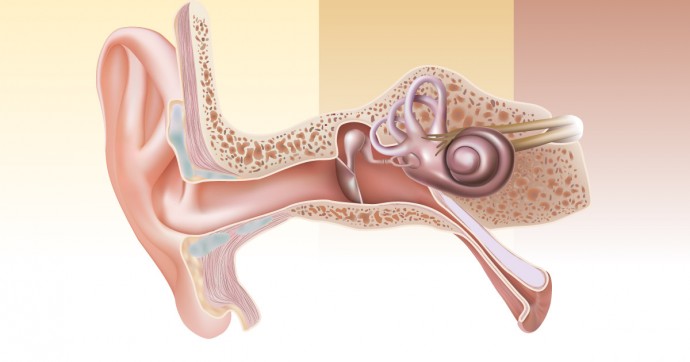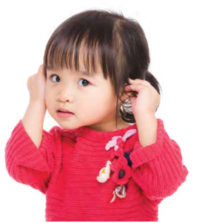Ear infection is very common in children and one of the most common reasons for trips to a paediatrician. In Malaysia, it is estimated that at least half a million cases of middle ear infection occur annually in children below two years. Middle ear infection, also known as otitis media, is a common ear infection. It can be divided into several types: acute or chronic otitis media, and otitis media with effusion. Another common type of ear infection is swimmer’s ear, or acute otitis externa, which affects the outer ear canal.
Acute otitis media (AOM) is a bacterial/viral infection of the middle ear; often a result from flu, allergy or other respiratory infections. This illness causes congestion and swelling of the Eustachian tube (a connection that links the middle ear to the respiratory tract), leading to the accumulation of fluid in the middle ear. This provides a perfect place for germs to breed. It occurs within 3 weeks to less than 3 months. Chronic otitis media is an occurrence of ear discharge for more than 3 months. Chronic otitis media causes less ear pain but persistent ear discharge. Meanwhile, otitis media with effusion (OME) is an inflammation and fluid build-up in the middle ear without any infection. The fluid build-up may persist after AOM has resolved. OME may have no clear symptoms, but if it keeps recurring, the child may be susceptible to new ear infections and his hearing can be affected.
Otitis externa is an infection of the ear canal, which is a tube that runs from the outside of the ear to the eardrum. It is usually caused by bacteria, but sometimes can be brought on by a virus or fungus. The infection may be caused by sticking objects into the ear or when moisture is trapped in the ear after swimming or bathing. Unlike otitis media, otitis externa is not accompanied by other illnesses.
What are the signs?
Acute Otitis Media
- Ear pain
- Trouble hearing
- Thick mucoid fluid draining out of the ear
- Fever and headache
- Difficulty sleeping
- Loss of balance
- Loss of appetite
Otitis Externa
- Ear pain
- Trouble hearing
- Clear fluid draining out of the ear
- Pain when pressing or tugging ear
- Itchiness in the ear
Who is at risk?
Otitis media: Children aged 6 months to 2 years are more susceptible to otitis media because their Eustachian tubes are narrower and more horizontal, making them more difficult to drain and more likely to get clogged. It is also more common during the cold or flu seasons. Poor air quality, due to exposure to cigarette smoke or air pollution also increases the risk of ear infection. Children who are sent to a nursery or who have many siblings also have a higher risk of infection.
Otitis externa: It is more common in children up to their early teensdue to the size and shape of their ear canal. As reflected in the name, swimmer’s ear happens to people who swim frequently. Skin problems like eczema or psoriasis also raise the odds of getting otitis externa, as well as the use of cosmetics or hair products that can irritate the skin.
Silent danger
Usually, ear infections do not cause long-term complications, but frequent or persistent infections can result in serious complications like impaired hearing, leading to speech and developmental delays. Infections can clear up on their own within one week. Doctors may prescribe antibiotics in the form of eardrops or oral suspension if necessary. Pain medication or other relief methods may also be prescribed to manage pain.
Although AOM is a common illness, it is also a risk factor to other fatal complications, such as acute mastoiditis, neck abscesses, meningitis, and bacteraemia, which occur when bacteria causing the infection spread to vital organs such as the brain and lungs. The same strains of bacteria most commonly found in infected middle ear, like Haemophilus influenzae and Streptococcus pneumoniae, are also responsible for these serious complications that can cause permanent disabilities, like hearing loss, and even death.
Prevention is best
Standard prevention measures include practising hygiene care to prevent the common cold and other illnesses. Teach your child to wash hands frequently and properly, and to cover his face when sneezing or coughing. Also, keep your child from being exposed to second-hand smoke and air pollution. If possible, breast-feed your child at least for the first six months. Breast milk contains antibodies that may offer protection from ear infections.
Vaccination can also prevent ear infection. The conjugate pneumococcal vaccine is very effective against several strains of bacteria that commonly cause ear infections. This include strains that also cause more severe diseases such as meningitis and pneumonia. Thus, vaccination also helps to prevent these related diseases in addition to ear infection. Seasonal flu shots may also help prevent ear infections. Consult your doctor on suitable vaccines for your child. Ear infection may be a typical illness in children, but remember that there are risks of being inflicted with more serious complications.







Comments